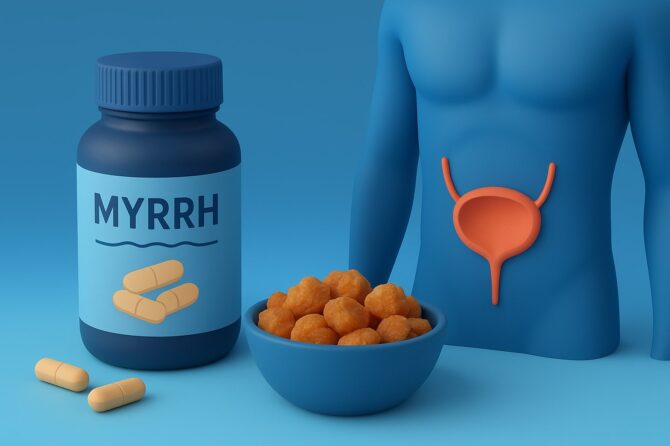
The Health Benefits of Myrrh — A Focus on Men’s Health, Prostate Health, and Urinary Function
Myrrh (Commiphora myrrha), a resin obtained from the small, thorny trees native to northeastern Africa and the Middle East, has been used for centuries in traditional medicine. From ancient Egypt to Traditional Chinese Medicine (TCM), Myrrh has played a vital role as an anti-inflammatory, analgesic, and antiseptic agent. In modern times, scientific inquiry has begun to validate many of these traditional claims, especially its relevance to chronic inflammation, immune modulation, and urogenital health.
Botanical and Chemical Profile of Myrrh
Myrrh resin is derived from the bark of trees in the Commiphora species. The gum-resin exudate contains a complex mixture of bioactive compounds:
- Terpenoids (e.g., furanosesquiterpenes, eudesmanes, and elemane derivatives)
- Guggulsterones
- Essential oils (α-pinene, limonene, myrcene)
- Resins and gums
The furanosesquiterpenes, in particular, have been shown to possess potent anti-inflammatory, anti-proliferative, and immunomodulatory effects, which are relevant to conditions involving chronic inflammation—such as prostatitis and benign prostatic hyperplasia (BPH).
Pharmacological Actions of Myrrh
Studies confirm that Myrrh exhibits a wide range of bioactive properties that impact various systems:
- Anti-inflammatory – Suppression of pro-inflammatory cytokines (TNF-α, IL-6, IL-1β) and downregulation of COX-2 enzyme activity
- Antimicrobial – Broad-spectrum activity against bacteria, fungi, and parasites
- Antioxidant – Scavenging free radicals and reducing oxidative stress, particularly in urogenital tissues
- Analgesic – Inhibition of pain pathways, beneficial in chronic pelvic pain syndromes
- Anti-cancerous – Evidence of cytotoxic effects on prostate and breast cancer cell lines in vitro
Myrrh and Men’s Health
1. Prostate Health
The prostate is particularly vulnerable to chronic inflammation, oxidative damage, and hormonal imbalances—conditions that Myrrh may positively influence.
- Anti-inflammatory activity: Myrrh reduces inflammatory responses in prostate tissues, potentially easing symptoms of chronic prostatitis and BPH.
- Hormonal modulation: Animal studies suggest Myrrh may mildly influence androgen levels, although further clinical studies are necessary.
- Anti-tumor potential: In vitro studies (e.g., on DU145 prostate cancer cells) show that certain Myrrh extracts induce apoptosis and inhibit proliferation of cancerous cells.
Clinical Insight: While no large-scale human trials yet confirm Myrrh’s efficacy in treating BPH or prostate cancer, its inclusion in phytotherapeutic blends (with Saw Palmetto or Pygeum) is growing in popularity for holistic prostate care.
2. Urinary Benefits
Myrrh’s impact on the urinary system is linked to its antimicrobial and anti-inflammatory profile.
- UTI prevention: Traditional medicine supports its use in preventing and treating urinary tract infections, particularly in men with residual urine or bladder dysfunction from BPH.
- Pelvic inflammation relief: Myrrh may help in cases of chronic pelvic pain syndrome (CPPS) by reducing inflammation in the lower urinary tract.
- Bladder tone: Myrrh’s antispasmodic properties may aid bladder function, though this effect remains under-studied.
3. Libido, Fertility, and Hormonal Balance
Though less documented, anecdotal and historical uses of Myrrh suggest:
- Aphrodisiac effects: In TCM and Ayurvedic medicine, Myrrh was believed to improve male vitality and libido.
- Sperm health: One rodent study found Myrrh extracts improved sperm motility and morphology, though human validation is still lacking.
Uses and Applications
Myrrh is available in multiple forms, including:
- Tinctures and extracts – Used in prostate and urinary support formulations.
- Capsules or tablets – Standardized doses of Myrrh resin extract.
- Essential oils – Occasionally used in aromatherapy for mood and endocrine support (not for internal use unless pharmaceutically prepared).
- Topical applications – For localized inflammation, though less relevant for internal prostate or urinary conditions.
Recommended Ingestion Methods
- Capsules/Tablets (300–600 mg/day):
- Standardized to furanosesquiterpenes or guggulsterones.
- Best taken with food to reduce gastrointestinal irritation.
- Tincture (1–2 ml, 2x/day):
- Alcohol-based extracts with rapid absorption.
- Used in combination formulas for urinary or hormonal balance.
- Decoction or Resin:
- Less common today due to bitter taste and variability in dosage.
- Still used in traditional systems.
Caution: Myrrh should not be used in high doses or during active bleeding disorders, pregnancy, or without supervision in individuals on anticoagulants or anti-hypertensives.
Safety and Contraindications
- Generally well-tolerated, but may cause:
- Nausea or diarrhea in sensitive individuals
- Uterine stimulation (contraindicated in pregnancy)
- Interaction with anticoagulants or diabetes medications
Toxicological studies in rodents suggest a wide margin of safety for short-term use. However, long-term human data are limited.
Conclusion
Myrrh stands as a promising phytomedicine with emerging evidence for its supportive role in men’s health, particularly for prostate inflammation, chronic pelvic conditions, and urinary tract health. While more robust clinical trials are needed to fully integrate Myrrh into conventional urology, its antioxidant, anti-inflammatory, and antimicrobial activities justify its inclusion in functional and integrative medicine for male wellness.
Its long-standing historical use, combined with modern pharmacological insights, makes Myrrh a compelling option in the landscape of botanical support for men over 40, especially those dealing with lower urinary tract symptoms or early-stage prostate challenges.
Leave a reply

Leave a reply